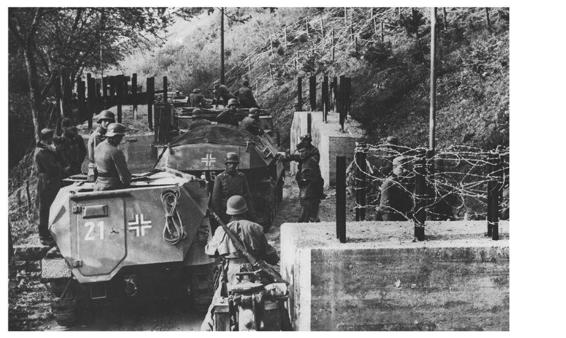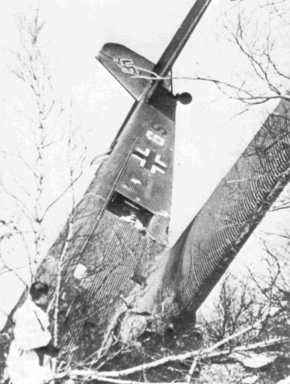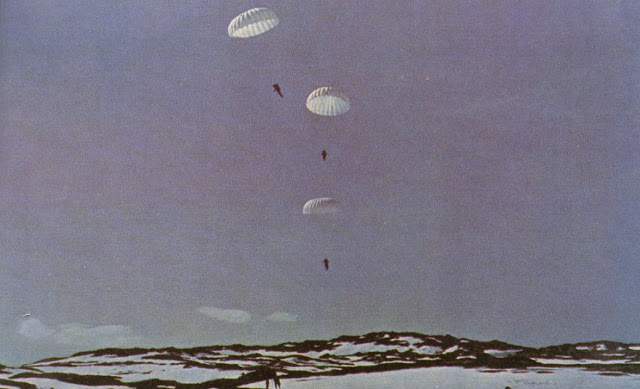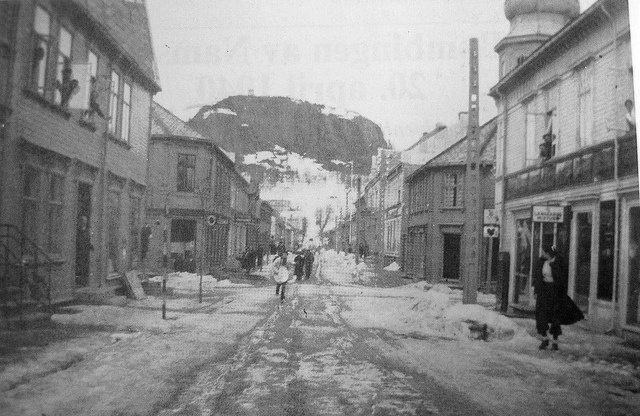Saturday 11 May 1940
 |
| Belgian soldiers surrender to German paratroopers at the bridge at Veldwezelt, 11 May 1940 (Ang, Federal Archive). |
Western Front: The German offensive continues rolling on 11 May 1940. William Shirer, a US journalist, notes that there are "Great headlines today in Berlin papers over 'shameful' protests of the Low Countries against being invaded."
The 9th Panzer Division crosses the Meuse and finds an undefended bridge over the Zuid-Willemsvaart canal 50 miles from Rotterdam, enabling it to continue rolling westward.
The trapped Belgian troops at fortress Eben Emael surrender to the German 7th Flieger Division, clearing the pathway for the 6th Army to proceed over the Maas Canal and completing one of the most brilliant aerial assaults in history. German 6th Army pulls up to the Albert Canal below the fortress and sends tank spearheads across, which requires rushed reinforcements from further south - where the Germans are quietly rolling their main force through the Ardennes.
The Battle of the Grebbeberg gets rolling. This is the main defense line forward of "Fortress Holland" in the west. The Grebbeberg is a hill near Rhenen which offers panoramic views (a zoo which is a major tourist attraction is on the hill). German artillery of the 18th Army opens fire before dawn on the line's outposts, disabling Dutch communications. At first light, the SS brigade attacks. The Germans breach the right side of the line, which enables the attackers to surround the rest of the line. The entire outpost line falls. However, the hill itself - protected by a 47 mm (1.85 inches) gun) remains inviolate. The Dutch counterattack, but it degenerates into a chaotic disaster with Dutch units firing on each other - but it does forestall the Germans' own night attack.
The German columns pushing through the Ardennes face logistical issues on the forest roads, but no significant defenders. General Erwin Rommel's 7th Panzer "Ghost" Division is in the lead of Army Group A and disperses a French Cavalry Unit guarding the road. Allied bombers are noticeably absent, partly due to Luftwaffe air superiority.
The French 1st Army, 7th Army, 9th Army, and British Expeditionary Force execute the "Dyle Plan," advancing to take up defensive positions on the Dyle River line. The German main assault does not lie there. Retreating Belgian troops join them. Hitler, when informed of his classic decoy move producing the desired results, says "I could weep for joy!"
The Fallschirmjäger (paratroops) operation at The Hague is one of the few blemishes on the Fall Gelb offensive. Generalleutnant Hans Graf von Sponeck's paratroops are scattered across dunes and do not control any of the airports they were dropped to capture. With his objective now impossible, von Sponeck receives orders to aid the assault on Rotterdam. In reality, he and his men now are hunted fugitives behind enemy lines, with hundreds of wounded and missing troops.
The paratroopers at Rotterdam are doing somewhat better. The 22nd Flieger Division holds bridges over the Niewe Maas River. The Dutch Marines launch furious attacks, but the paratroopers have nowhere to retreat to anyway, so a stalemate develops - which is to the Germans' benefit.
European Air Operations: The Luftwaffe is concentrating on ground support missions - a key element of "Blitzkrieg." The Allies are hampered by few airbases close to the scene of the battles and, quite frankly, often inferior equipment.
In terms of that equipment, the Fairey Battle light bomber is struggling. The RAF sends eight of them to attack German troops in Luxembourg and only one returns.
The Luftwaffe also is aggressively targeting Allied airfields. They make a low-level attack on the field of No. 114 Squadron and destroy its Bristol Blenheim bombers on the ground.
The Luftwaffe sinks Dutch liners Statendam and Veendam at Rotterdam.
The RAF sends 23 aircraft to attack bridges over the Maas at Maastricht, which the Germans captured on the 10th.
Overnight, the RAF sends 37 bombers to attack Monchengladbach - the first RAF bombing of a German town without military priority.
Battle of the Atlantic: U-9 (Oberleutnant zur See Wolfgang Lüth) torpedoes and sinks 1,930-ton British freighter Tringa just off the West Hinder buoy at the mouth of the Scheldt River. There are 6 survivors and 17 perish.
U-9 also sinks 1,908-ton Estonian freighter Viiu. There are 5 survivors and 15 perish.
British submarine HMS Narwhal sinks Kriegsmarine vessel V-1109.
HMS Seal, the only British submarine captured during the war, arrives in Frederikshavn, Denmark, under tow by German "UJ 128" (Unterseebootsjäger 128). It is immediately investigated by German technicians.
Convoy OA 146 departs from Southend, Convoy OB 146 departs from Liverpool.
US Government: President Roosevelt fulfills various obligations under the Neutrality Laws, issuing executive orders :
War Crimes: The British Air Ministry takes the radical step of authorizing attacks on purely civilian targets in Germany. This is a clear violation of international law which the Germans have violated as well in Poland and Finland. While this particular decision is not considered a war crime by many historians and "they did it first"... if things had turned out differently, it would be. War can be unavoidably morally ambiguous.
Dutch Commander of 2nd Corps General Harberts at Grebbeberg impanels a summary court-martial of a sergeant, Chris Meijer, accused of abandoning his post. Meijer is shot by firing squad the same day. There are possible issues of undue influence of Harberts in the matter with murky motivations.
Norway: British General Claude Auchinleck is in command of the British-French ground forces of what has become a classic sideshow campaign. Even that is not going well for the Allies.
The two Independent Companies and accompanying British light anti-aircraft detachments (who have to abandon their equipment) at Mosjøen evacuate during the early morning hours on Norwegian vessel Erling Jarl. Lt. Col. Gubbins pays the owners 5000 kroner for their assistance. The accompanying Norwegians are forced to retreat by road after the Germans occupied Hemnesberget on the 10th by using the commandeered vessel Nordnorge.
The German 2nd Mountain Division troops at Hemnesberget attack toward Mo i Rana. Other troops from the division occupy the evacuated Mosjøen. Still, other units of the division continue their march north toward Narvik to relieve General Dietl's regiment there.
German/Swedish Relations: A Swedish delegation meets with Hermann Goering regarding German use of the Narvik railway which runs through Sweden.
Caribbean: British and French troops continue occupying Dutch islands such as Curaçao and Aruba. President Roosevelt states that these actions do not violate the Monroe Doctrine (no foreign military actions in the Americas).
China: At the Battle of Tsaoyang-Ichang, the Chinese 5th War Area attacks the Japanese 11th Army around Tsaoyang, Tungpo, and Mingkang, but the Japanese break out of the encirclement and retreat eastward.
Belgian Homefront: The roads are clogged with refugees fleeing westward and southward. Most are on foot or on their bicycles. The Mayor of Bouillon, in a classic "business, is business" reaction to the war, refuses to quarter troops in hotels: "This is a resort town! Hotels are reserved for tourists."
Dutch Homeland: Former Kaiser Wilhelm, living in exile in Holland, has had a somewhat dismissive opinion of Hitler. However, he refuses Winston Churchill's offer of sanctuary in the UK.
British Homefront: The Manchester Guardian publishes an editorial stating that new Prime Minister Churchill "takes office with greater goodwill than any of our modern history."
"Contraband" starring Conrad Veidt hits the theatres. Veidt is a Lutheran German World War I veteran who fled Germany in 1933 due to the specter of Hitler's persecution of his Jewish wife.
May 2, 1940: British Depart Namsos
May 3, 1940: Many Norwegians Surrendering
May 4, 1940: Bader Returns
May 5, 1940: HMS Seal Survives
May 6, 1940: Allies Focus on Narvik
May 7, 1940: In The Name of God, Go!
May 8, 1940: Exit Chamberlain
May 9, 1940: Enter Churchill
May 10, 1940: Fall Gelb
May 11, 1940: Eben Emael Surrenders
May 12, 1940: Germans at Sedan
May 13, 1940: Rommel at Work
May 14, 1940: German Breakout in France
May 15, 1940: Holland Surrenders
May 16, 1940: Dash to the Channel
May 17, 1940: Germans Take Brussels
May 18, 1940: Germans Take Antwerp
May 19, 1940: Failed French Counterattack
May 20, 1940: Panzers on the Coast
May 21, 1940: Battle of Arras
May 22, 1940: Attacking Channel Ports
May 23, 1940: British Evacuate Boulogne
May 24, 1940: Hitler's Stop Order
May 25, 1940: Belgian Defenses Creaking
May 26, 1940: Operation Dynamo
May 27, 1940: King Leopold Surrenders
May 28, 1940: The Allies Take Narvik
May 29, 1940: Lille Falls
May 30, 1940: Operation Fish
May 31, 1940: Peak Day for Dynamo
2020
The 9th Panzer Division crosses the Meuse and finds an undefended bridge over the Zuid-Willemsvaart canal 50 miles from Rotterdam, enabling it to continue rolling westward.
The trapped Belgian troops at fortress Eben Emael surrender to the German 7th Flieger Division, clearing the pathway for the 6th Army to proceed over the Maas Canal and completing one of the most brilliant aerial assaults in history. German 6th Army pulls up to the Albert Canal below the fortress and sends tank spearheads across, which requires rushed reinforcements from further south - where the Germans are quietly rolling their main force through the Ardennes.
The German columns pushing through the Ardennes face logistical issues on the forest roads, but no significant defenders. General Erwin Rommel's 7th Panzer "Ghost" Division is in the lead of Army Group A and disperses a French Cavalry Unit guarding the road. Allied bombers are noticeably absent, partly due to Luftwaffe air superiority.
The French 1st Army, 7th Army, 9th Army, and British Expeditionary Force execute the "Dyle Plan," advancing to take up defensive positions on the Dyle River line. The German main assault does not lie there. Retreating Belgian troops join them. Hitler, when informed of his classic decoy move producing the desired results, says "I could weep for joy!"
The Fallschirmjäger (paratroops) operation at The Hague is one of the few blemishes on the Fall Gelb offensive. Generalleutnant Hans Graf von Sponeck's paratroops are scattered across dunes and do not control any of the airports they were dropped to capture. With his objective now impossible, von Sponeck receives orders to aid the assault on Rotterdam. In reality, he and his men now are hunted fugitives behind enemy lines, with hundreds of wounded and missing troops.
The paratroopers at Rotterdam are doing somewhat better. The 22nd Flieger Division holds bridges over the Niewe Maas River. The Dutch Marines launch furious attacks, but the paratroopers have nowhere to retreat to anyway, so a stalemate develops - which is to the Germans' benefit.
 |
| 'The biggest traffic jam in history': German armor squeezes through the narrow gorges of the Ardennes on its way to France on 11 May 1940. |
In terms of that equipment, the Fairey Battle light bomber is struggling. The RAF sends eight of them to attack German troops in Luxembourg and only one returns.
The Luftwaffe also is aggressively targeting Allied airfields. They make a low-level attack on the field of No. 114 Squadron and destroy its Bristol Blenheim bombers on the ground.
The Luftwaffe sinks Dutch liners Statendam and Veendam at Rotterdam.
The RAF sends 23 aircraft to attack bridges over the Maas at Maastricht, which the Germans captured on the 10th.
Overnight, the RAF sends 37 bombers to attack Monchengladbach - the first RAF bombing of a German town without military priority.
Battle of the Atlantic: U-9 (Oberleutnant zur See Wolfgang Lüth) torpedoes and sinks 1,930-ton British freighter Tringa just off the West Hinder buoy at the mouth of the Scheldt River. There are 6 survivors and 17 perish.
U-9 also sinks 1,908-ton Estonian freighter Viiu. There are 5 survivors and 15 perish.
British submarine HMS Narwhal sinks Kriegsmarine vessel V-1109.
HMS Seal, the only British submarine captured during the war, arrives in Frederikshavn, Denmark, under tow by German "UJ 128" (Unterseebootsjäger 128). It is immediately investigated by German technicians.
Convoy OA 146 departs from Southend, Convoy OB 146 departs from Liverpool.
US Government: President Roosevelt fulfills various obligations under the Neutrality Laws, issuing executive orders :
- Recognizing the state of war that exists between Germany and Belgium, Luxembourg and the Netherlands;
- Proclaiming American neutrality in the conflict; and
- Restricting belligerent submarines from using American ports and territorial waters, exclusive of the Panama Canal Zone.
War Crimes: The British Air Ministry takes the radical step of authorizing attacks on purely civilian targets in Germany. This is a clear violation of international law which the Germans have violated as well in Poland and Finland. While this particular decision is not considered a war crime by many historians and "they did it first"... if things had turned out differently, it would be. War can be unavoidably morally ambiguous.
Dutch Commander of 2nd Corps General Harberts at Grebbeberg impanels a summary court-martial of a sergeant, Chris Meijer, accused of abandoning his post. Meijer is shot by firing squad the same day. There are possible issues of undue influence of Harberts in the matter with murky motivations.
Norway: British General Claude Auchinleck is in command of the British-French ground forces of what has become a classic sideshow campaign. Even that is not going well for the Allies.
The two Independent Companies and accompanying British light anti-aircraft detachments (who have to abandon their equipment) at Mosjøen evacuate during the early morning hours on Norwegian vessel Erling Jarl. Lt. Col. Gubbins pays the owners 5000 kroner for their assistance. The accompanying Norwegians are forced to retreat by road after the Germans occupied Hemnesberget on the 10th by using the commandeered vessel Nordnorge.
The German 2nd Mountain Division troops at Hemnesberget attack toward Mo i Rana. Other troops from the division occupy the evacuated Mosjøen. Still, other units of the division continue their march north toward Narvik to relieve General Dietl's regiment there.
German/Swedish Relations: A Swedish delegation meets with Hermann Goering regarding German use of the Narvik railway which runs through Sweden.
Caribbean: British and French troops continue occupying Dutch islands such as Curaçao and Aruba. President Roosevelt states that these actions do not violate the Monroe Doctrine (no foreign military actions in the Americas).
China: At the Battle of Tsaoyang-Ichang, the Chinese 5th War Area attacks the Japanese 11th Army around Tsaoyang, Tungpo, and Mingkang, but the Japanese break out of the encirclement and retreat eastward.
Belgian Homefront: The roads are clogged with refugees fleeing westward and southward. Most are on foot or on their bicycles. The Mayor of Bouillon, in a classic "business, is business" reaction to the war, refuses to quarter troops in hotels: "This is a resort town! Hotels are reserved for tourists."
Dutch Homeland: Former Kaiser Wilhelm, living in exile in Holland, has had a somewhat dismissive opinion of Hitler. However, he refuses Winston Churchill's offer of sanctuary in the UK.
British Homefront: The Manchester Guardian publishes an editorial stating that new Prime Minister Churchill "takes office with greater goodwill than any of our modern history."
"Contraband" starring Conrad Veidt hits the theatres. Veidt is a Lutheran German World War I veteran who fled Germany in 1933 due to the specter of Hitler's persecution of his Jewish wife.
May 1940
May 1, 1940: British Leave ÅndalsnesMay 2, 1940: British Depart Namsos
May 3, 1940: Many Norwegians Surrendering
May 4, 1940: Bader Returns
May 5, 1940: HMS Seal Survives
May 6, 1940: Allies Focus on Narvik
May 7, 1940: In The Name of God, Go!
May 8, 1940: Exit Chamberlain
May 9, 1940: Enter Churchill
May 10, 1940: Fall Gelb
May 11, 1940: Eben Emael Surrenders
May 12, 1940: Germans at Sedan
May 13, 1940: Rommel at Work
May 14, 1940: German Breakout in France
May 15, 1940: Holland Surrenders
May 16, 1940: Dash to the Channel
May 17, 1940: Germans Take Brussels
May 18, 1940: Germans Take Antwerp
May 19, 1940: Failed French Counterattack
May 20, 1940: Panzers on the Coast
May 21, 1940: Battle of Arras
May 22, 1940: Attacking Channel Ports
May 23, 1940: British Evacuate Boulogne
May 24, 1940: Hitler's Stop Order
May 25, 1940: Belgian Defenses Creaking
May 26, 1940: Operation Dynamo
May 27, 1940: King Leopold Surrenders
May 28, 1940: The Allies Take Narvik
May 29, 1940: Lille Falls
May 30, 1940: Operation Fish
May 31, 1940: Peak Day for Dynamo
2020





